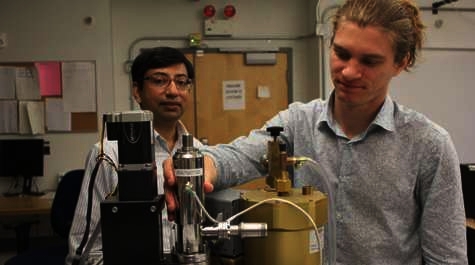Researchers Create Wearable Yeast-Based Radiation Sensor

A new radiation sensor developed by Purdue University researchers is a wearable, disposable, film-type device fabricated on a paper substrate with cells of the yeast (Saccharomyces cerevisiae) patterned between two electrodes and used as a smart material. The device, described in the journal Advanced Biosystems, is sensitive to radiation when dry and is read by activating it with water.
Workers in hospitals and nuclear facilities can wear disposable yeast badges to check their daily radiation exposure instantly. Image credit: Kayla Wiles, Purdue University.
Radiology workers are regularly exposed to low doses of radiation when they obtain patient imagery, such as X-rays.
While protective gear largely keeps workers within a safe range of radiation exposure, absorbing a little bit is still inevitable.
Radiation doses creeping above regulated guidelines pose risk for developing conditions such as cancer, cataracts, skin irritation or thyroid disease.
“Currently, radiology workers are required to wear badges, called dosimeters, on various parts of their bodies for monitoring their radiation exposure,” said Purdue University Professor Babak Ziaie.
“They wear the badges for a month or two, and then they send them to the company that made them. But it takes weeks for the company to read the data and send a report back to the hospital. Ours give an instant reading at much lower cost.”
The success of the team’s sensor lies in the quick and measurable response of yeast to radiation: the higher the radiation dose, the higher the percentage of yeast cells that die.
Wetting the badge activates the cells that are still alive to eat glucose and release carbon dioxide — the same fermentation process responsible for brewing beer and making bread rise.
When carbon dioxide bubbles at the surface, ions also form. The concentration of these ions increases the electrical conductivity of yeast, which can be measured by hooking up the badge to a readout system.
“We use the change in electrical properties of the yeast to tell us how much radiation damage it incurred,” said Dr. Rahim Rahimi, from the Purdue University’s Birck Nanotechnology Center.
“A slow decrease in electrical conductivity over time indicates more damage.”
Numbers from the readout system translate to rads — the units used by entities like the Occupational Safety and Health Administration to specify limits on how much radiation human tissue can safely absorb.
Skin of the whole body, for example, shouldn’t be exposed to more than 7.5 rad over a three month period.
The researchers could detect a radiation dose as little as 1 millirad in the yeast badges, which is comparable to current commercial badges.
Yeast also is known to be genetically similar to human tissue. Data from the badges can, therefore, inform future work on how radiation damage happens to human DNA and proteins.
“For yeast, it seems that radiation primarily affects the cell walls of the membrane and mitochondria,” said Dr. Manuel Ochoa, also from the Purdue University’s Birck Nanotechnology Center.
“Since biologists are already familiar with yeast, then we’re more likely to understand what’s causing the biological effects of radiation in organic matter.”





